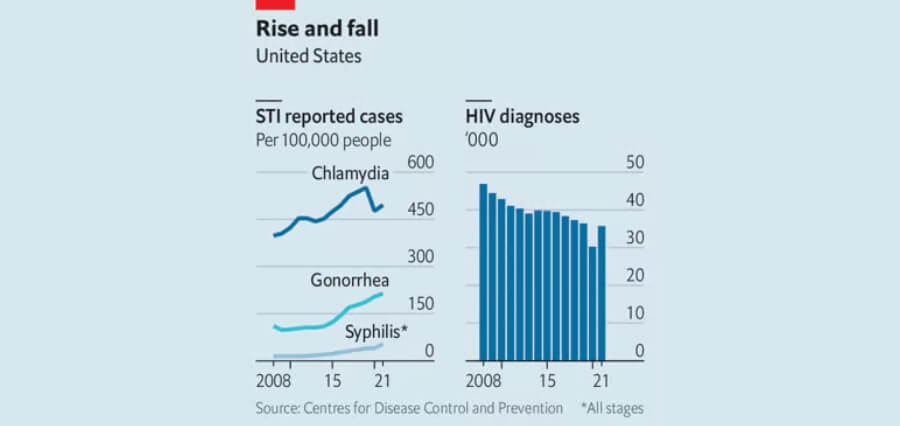It appeared as though syphilis would be eradicated in America twenty years ago. Additionally, gonorrhea rates were falling. Today, syphilis, gonorrhea, and chlamydia—three of the most prevalent sexually transmitted illnesses (STIs)—are at record highs, particularly among gay men and members of specific ethnic minority groups (refer to the chart). Gonorrhea and syphilis reached their peak points in 2021, 1991 and 1990, respectively. Twenty years has seen a roughly twofold increase in chlamydia cases. Babies are impacted as well. The Centers for Disease Control and Prevention (CDC) revealed on November 7th that the number of newborns born to infected moms who contract congenital syphilis jumped tenfold between 2012 and 2022.
It is vital to comprehend and treat the epidemic from both a public health and medical standpoint as STI rates rise in the United States. In order to address the epidemic from a population perspective, prevention initiatives are crucial. These can include social media awareness campaigns and HPV vaccination.
Sexually transmitted infections are disease processes that are spread by sexual intercourse between individuals who are in intimate physical touch with one another. Previously referred to as sexually transmitted diseases, sexually transmitted infections are caused by an organism that is transferred from one sexual partner to another by the mouth, the anal canal, or the vagina. All persons are susceptible to sexually transmitted illnesses, but they can be avoided with appropriate information and barrier management. STIs are more common in medically deprived populations and are often underrecognized. In addition to reviewing the role of the interprofessional team in managing patients with this illness, this exercise describes the evaluation and management of sexually transmitted infections.
All public health organizations should be aware that sexually transmitted diseases (STIs) are a global health concern. We’ll go over the causes of the most prevalent STIs, their symptoms, physical manifestations, complications, and the impact they have on afflicted individuals and their families. STIs are more common in medically deprived populations and are often underrecognized.
The particular organism, pathogen, signs, and symptoms of the disease all influence the presenting condition or sickness. Unprotected sexual contact with multiple partners, a history of STIs, sexual assault, alcohol consumption, prostitution, having a partner with multiple concurrent sexual contacts or a history of STIs, recreational drug use, and intravenous drug use are risk factors that increase the transmission of STIs.
Read more: https://thecareworld.com/





